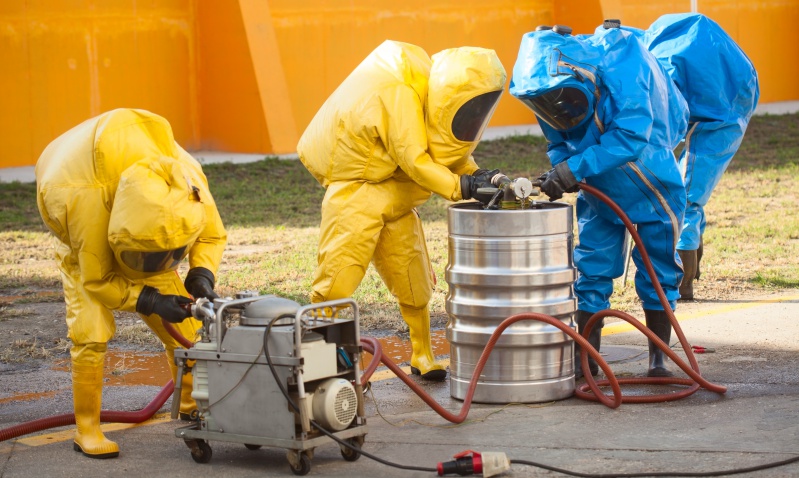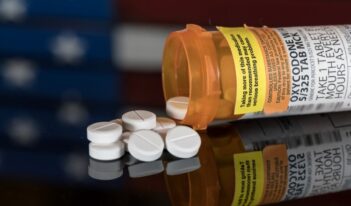
Regulations on decontaminating former meth labs vary across federal and state governments.
As the opioid crisis rages on, the powerful, highly addictive stimulant methamphetamine (meth) has made a silent but deadly comeback in the United States.
Although the number of domestic clandestine meth labs has declined, meth production poses public health and environmental risks to those who live in or around former labs. Unfortunately, only about 10 percent of illicit labs are ever identified, increasing the possibility that many individuals occupy dangerous properties.
The synthesis of one pound of meth creates six times as much hazardous chemicals that are then released into the environment through illicit dumping. Given the colorless, odorless qualities of these dangerous byproducts, many individuals are not aware of their exposure to these toxins until they develop side effects such as headaches, respiratory issues, chemical burns, and even cancer.
The United States currently has only a patchwork of federal and state guidelines on meth lab cleanup—some of which have proven incomplete. No federal law exists to support meth lab cleanup efforts after sites are discovered. Instead, the federal government has relied on guidance to instruct public officials, first responders, industrial hygienists, and the public on safety procedures and the potential hazards of meth lab contamination.
The first major effort to curb the threat of illegal meth production came in 1990, when the federal government developed a task force of experts from several federal agencies. The task force sought to help state governments conduct initial cleaning of clandestine drug labs by establishing national guidance on best practices for safely entering a meth lab and removing contaminants.
Although the task force’s guidance provided an overview of first responder issues, the guidance did little to address remediation—the process by which a site is cleaned of any residual contaminants to ensure safety for future inhabitants—due to a lack of scientific understanding of the process at that time.
Nearly 20 years later, the U.S. Congress passed the Methamphetamine Remediation Research Act, which tasked the U.S. Environmental Protection Agency (EPA) with issuing voluntary guidance on overhauling former meth labs. EPA released a guidance document in 2013, which outlines standards, techniques, and specific cleaning measures for items and materials commonly found in former meth labs.
Due to the dangerous nature of decontaminating properties, EPA advises that contractors with hazardous waste expertise conduct the remediation process. EPA recommends that contractors be certified in meth lab remediation, if such certification is available in the state in which the lab is located. For states that do not have certification standards, EPA suggests that contractors follow the U.S. Occupational Safety and Health Administration hazardous waste operations and emergency response regulations to mitigate the risk of potential exposure to toxins.
Contractors are responsible for ventilating the site, performing a preliminary assessment of the property, collecting samples of hazardous compounds, and developing and executing a cleanup strategy. EPA recommends that contractors first remove contaminated materials in compliance with state waste disposal rules. After all contaminated items are thrown away, EPA explains that contractors should use a vacuum with a high efficiency particulate air filter before washing surfaces and clearing plumbing with a specialized detergent solution. Contractors should repeat this process for the surrounding premises and prepare a final report based on post-remediation sample collection showing any remaining levels of meth and other toxins.
Unlike EPA’s qualitative guidance, state rules for cleaning meth labs often focus on quantitative remediation standards for evaluating the effectiveness of decontamination procedures. These numerical metrics reflect what scientific experts have determined to be the safest levels of remaining meth at a site. Some states also require other contaminants, such as lead, mercury, and iodine, to fall below certain levels before remediation is considered complete.
For example, Arkansas—the state with the second most meth labs per capita—is one of 25 states that uses a numerical system to determine remediation outcomes. The Arkansas Department of Environmental Quality (DEQ) requires contractors to collect a specific concentration of surface samples. To be considered effective, these samples cannot have concentrations of meth or other toxins above DEQ-specified levels.
In addition to the state’s remediation regulations, the Arkansas State Legislature passed a bill that authorizes the DEQ to create a state certification program for contractors. The DEQ now mandates that contractors maintain an updated state certification to remediate labs.
Arkansas’s law is also intended to protect property owners from contamination by former meth production by requiring the DEQ to create a recordkeeping system of former clandestine labs. Although there are over 700 properties listed in the DEQ’s database, most of these properties remain contaminated. Some public officials question whether the DEQ’s regulations are actually effective in protecting residents.
One problem could be that Arkansas’s law places responsibility on residents of the contaminated property to hire certified contractors. Yet some owners may not check DEQ records of contaminated properties or fully understand the dangers of living in or near a former meth lab. Since the DEQ has no enforcement power to remove owners from a contaminated property under Arkansas’s meth lab laws, residents of such properties remain at risk of developing serious health conditions.
Gaps in state meth lab laws and regulations are not unique to Arkansas. Many states lack disclosure laws, quantitative remediation standards, contractor licensing regulations, and even cleanup protocols, leaving residents—often unknowingly—at risk of hazardous exposure.
As meth continues its ominous return, increasing in demand and claiming more lives to addiction, the United States could see a resurgence of domestic meth labs. Mending the current patchwork of regulations by establishing uniform cleanup requirements will likely prove important for protecting unsuspecting homeowners and renters from also falling victim to meth’s destruction.



